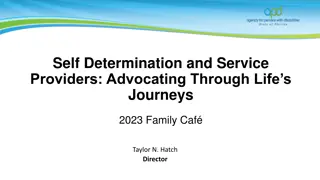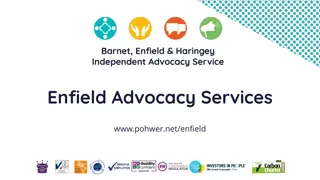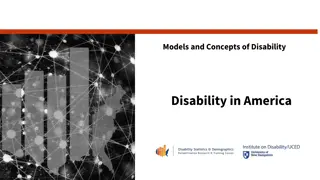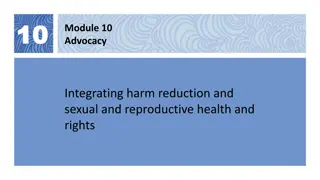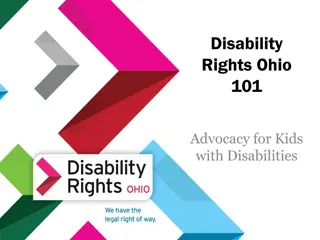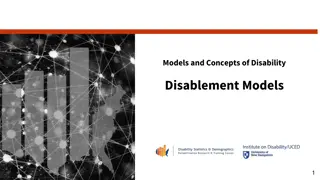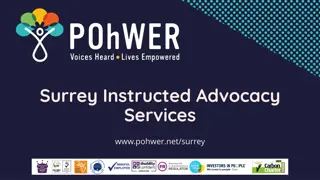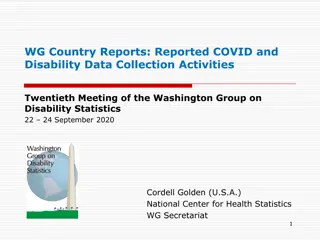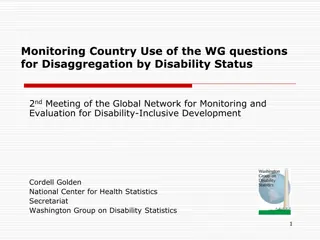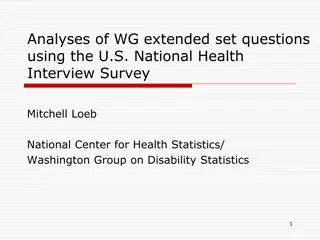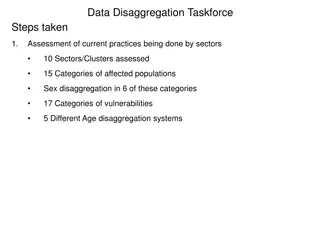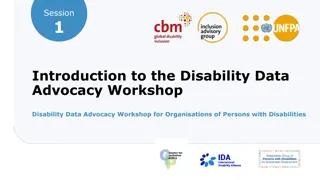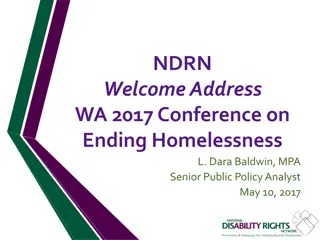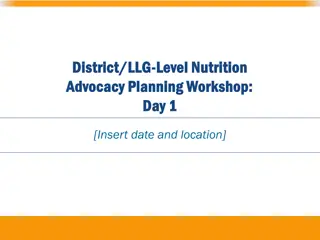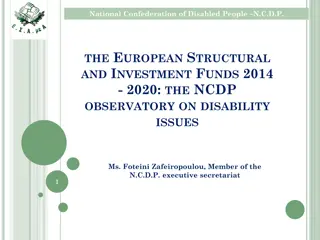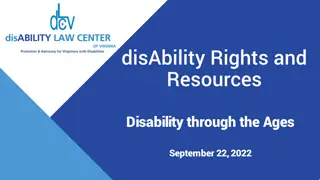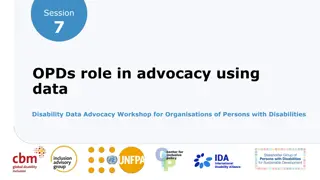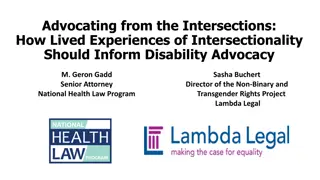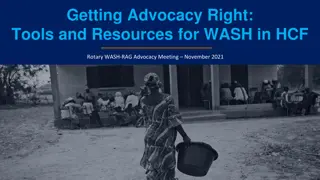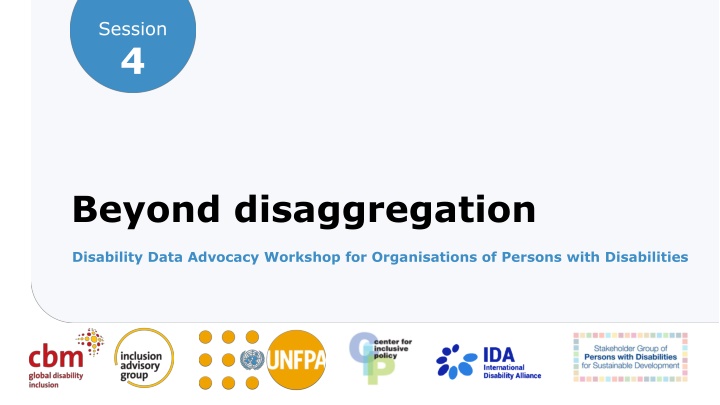
Disability Data Advocacy Workshop: Going Beyond Disaggregation
Delve into the importance of detailed disability data for effective advocacy work. Explore how data from the Washington Group-Short Set goes beyond identifying disabilities to reflect varying levels of difficulty across core functional domains. Understand how this in-depth information can inform policy-making, service planning, and advocacy efforts for organizations of persons with disabilities.
Download Presentation

Please find below an Image/Link to download the presentation.
The content on the website is provided AS IS for your information and personal use only. It may not be sold, licensed, or shared on other websites without obtaining consent from the author. If you encounter any issues during the download, it is possible that the publisher has removed the file from their server.
You are allowed to download the files provided on this website for personal or commercial use, subject to the condition that they are used lawfully. All files are the property of their respective owners.
The content on the website is provided AS IS for your information and personal use only. It may not be sold, licensed, or shared on other websites without obtaining consent from the author.
E N D
Presentation Transcript
Session 4 Beyond disaggregation Disability Data Advocacy Workshop for Organisations of Persons with Disabilities
Session overview 2 Disability Data Advocacy Workshop for Organisations of Persons with Disabilities SESSION 4
Overview of session Discuss additional uses of the WG-SS beyond disaggregation. Review the limitations of the WG-SS and possible ways to address the limitations. Highlight the data collection tool for children with disabilities Identify the information needed to go beyond disaggregation and build evidence for effective advocacy on how SDG targets are disability inclusive and how CRPD is being implemented. 3 Disability Data Advocacy Workshop for Organisations of Persons with Disabilities SESSION 4
Additional uses of the WG-SS 4 Disability Data Advocacy Workshop for Organisations of Persons with Disabilities SESSION 4
What can the WG-SS tell us beyond identifying the population with disabilities? Reminder that the WG-SS: Reflects a continuum of difficulty as opposed to a yes/no question Is six questions, reflecting the six core functional domains - difficulties with vision, hearing, walking cognition (concentrating or remembering), self-care and communication. Responses relate to the level of difficulty, including not at all , some of the time , most of the time and cannot do at all . This approach focused on levels of difficulty can also tell us about the: Prevalence of persons with disabilities, Level of support they might require, e.g., a person who cannot walk at all might need mobility device. People who may have difficulties across several domains 5 Disability Data Advocacy Workshop for Organisations of Persons with Disabilities SESSION 4
Why is it important to know more about the detail in the data? Detailed data on levels of difficulty can help policy makers understand the different needs a population might have to suitably plan services. Can help shape OPD advocacy efforts. For example, the World Blind Union research on the impact of COVID-19 on blind and partially sighted persons used the different levels of difficulty across all domains and found that: It was able to differentiate the levels of need among its members. In addition to having difficulty seeing, 18% of the respondents noted having at least one other significant level of difficulty from among the Washington Group questions asked. Having this level of detail about more than 1 domain, meant that WBU could understand and advocate better on the needs of its members. 6 Disability Data Advocacy Workshop for Organisations of Persons with Disabilities SESSION 4
How to assess if a data set is fit for use To determine whether a data set is fit for your intended use you can ask the following questions: 1. Are all functional domains of interest included? If not, which ones are omitted and how will this affect your use of the data? 2. Are the aspects covered for the disability of interest? If not, which ones are omitted and how will that affect your use of the data? 3. Do the questions adequately address the age range of interest? If not, where are the omissions and how will that affect your use of the data? 7 Disability Data Advocacy Workshop for Organisations of Persons with Disabilities SESSION 4
Limitations of the WG-SS 8 Disability Data Advocacy Workshop for Organisations of Persons with Disabilities SESSION 4
What are general limitations of the WG-SS? All questions have limitations; whether the limitations affect the quality of the data depends on the intended use of the data. The WG-SS has limitations because of the requirements it had to meet to serve its purpose. The WG-SS is designed: 1. For use with the whole population. 2. To be able to be administered in a census, which means: a. Keeping the number of questions to a minimum. b. Questions cannot be sensitive. 9 Disability Data Advocacy Workshop for Organisations of Persons with Disabilities SESSION 4
Does the WG-SS include all persons with disabilities? The WG-SS does not identify: Persons with psychosocial disabilities. Persons with upper body limitations. (unless these affect other domains such as self-care or communication) To address these limitations, the WG developed the WG-Extended Set and the WG-Enhanced Set of Questions. These include 2 questions each on upper body functioning and on anxiety and depression. These can be added to surveys such as those on labor force, living standards, health and education. 10 Disability Data Advocacy Workshop for Organisations of Persons with Disabilities SESSION 4
Child Functioning Module (CFM) a specific tool designed to gather data on children with disabilities 11 Disability Data Advocacy Workshop for Organisations of Persons with Disabilities SESSION 4
Disability in children The WG-SS: Is not appropriate for children under 5 years of age. Misses some children with developmental issues between 5 and 18 years of age. The WG and UNICEF developed the Child Functioning Module (CFM) to address these limitations. It follows the basic design of the WG-SS but includes functional domains of importance to children. It is included in UNICEF s Multiple Indicator Cluster Survey Program. 12 Disability Data Advocacy Workshop for Organisations of Persons with Disabilities SESSION 4
Beyond disaggregation using the data to build evidence for advocacy 13 Disability Data Advocacy Workshop for Organisations of Persons with Disabilities SESSION 4
Disaggregation tells us only one part of the story what other data is needed? The WG-SS does not tell us that environmental factors act as barriers or enablers for better inclusion (such as assistive devices, supportive regulations, accessible buildings). They also do not address the difference assistive devices may make for persons with disabilities To address the latter limitation, the WG-Enhanced Set includes questions on the use of mobility assistive devices and functioning with the use of these devices. However, other barriers and enablers are not addressed. To obtain this data, additional modules can be added to the existing data collection modules, or specific disability surveys exploring these factors can be conducted (or both). See Irish case study for further data collection based on initial use of WG-SS. 14 Disability Data Advocacy Workshop for Organisations of Persons with Disabilities SESSION 4
Advocating for inclusive employment what other information is needed? Data is needed on barriers and enablers of employment including: Accessibility of the physical environment, such as workplaces. Accessibility of transportation to, from and for work. Characteristics of working conditions, including flexibility. Legal and regulatory protections especially on workplace discrimination, or lack thereof. Attitudes of employers and other workers on disability. Some of these characteristics are included in the WG-ILO module on full employment that can be added to labor force surveys. 15 Disability Data Advocacy Workshop for Organisations of Persons with Disabilities SESSION 4
What additional information would help assess barriers and differences experienced by people with disabilities around employment? Information is needed on availability, need and receipt of services such as: Assistive devices Personal assistance General and specialized health care Educational opportunities This information can be obtained by adding the appropriate questions to surveys that also include questions to identify persons with disabilities. It can also be obtained through interviewing persons with disabilities about their experiences in the workplace, the barriers they face. 16 Disability Data Advocacy Workshop for Organisations of Persons with Disabilities SESSION 4
Summary of key points Disaggregation is critical to monitoring the CRPD and the SDGs, but disaggregation does not address other issues related to disability that are relevant for policy development and implementation. Other data is needed to obtain this information either by adding additional modules to the ongoing data collections or conducting a disability survey, or both. All data has limitations, it is critical to understand the limitations and determine how they might affect the use of data for advocacy. If appropriate data is not available, knowledge of the limitations of available data can be used to advocate for improved data. 17 Disability Data Advocacy Workshop for Organisations of Persons with Disabilities SESSION 4
End of session Please complete Individual Reflection Sheets for this session 18 Disability Data Advocacy Workshop for Organisations of Persons with Disabilities SESSION 4

